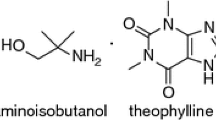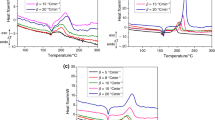Abstract
Data from theoretical, thermal, and spectroscopic methods were compared in order to map a possible mechanism for the thermal decomposition of furosemide, a diuretic compound, in solid state. TG/DTG curves suggested a two-stage decomposition process. The first product of decomposition is water (m/z = 18), released due to a dimerization resulting in the formation of an amide. Then carbon dioxide (m/z = 44), nitroxide (m/z = 30), and 2-methyl-furanyl ion (m/z = 81) are released in the second stage. The chlorine substituted benzene ring, due to the double bond conjugated system, being the last fraction to decompose. Theoretical calculations presented are in agreement with experimental results.






Similar content being viewed by others
References
Dias ILT, Oliveira Neto G, Martins JLS. Metodologias analíticas para a determinação da furosemida. Lecta. 2004;22:9–26.
Kreaz RMA, Novák Cs, Eros I, Kata M. Thermoanalytical studies on complexes of furosemide with b-cyclodextrin derivatives. J Therm Anal Calorim. 1999;55:115–22.
Shin SC, Kim J. Physicochemical characterization of solid dispersion of furosemide with TGPS. Int J Pharm. 2003;251:79–84.
Beyers H, Malan SF, van der Watt JG, Villiers MM. Structure-solubility relationship and thermal decomposition of furosemide. Drug Dev Ind Pharm. 2000;26:1077–83.
Kotev MI, Goto H, Ivanov PMJ. Molecular mechanics (CONFLEX/MM3) search/minimization study of the conformations of ornoside and escuside. J Mol Struct. 2005;748:9–16.
Allinger NL. Conformational analysis. 130. MM2. A hydrocarbon force field utilizing V1 and V2 torsional terms. J Am Chem Soc. 1977;99:8127–34.
Allinger NL, Yuh YH, Lii JH. Molecular mechanics. The MM3 force field for hydrocarbons. J Am Chem Soc. 1989;111:8551–65.
Bowen JP, Shim JY. Molecular mechanics studies of acyl halides: I. Molecular structures and conformational analysis. J Comput Chem. 1998;19:1370–86.
Dewar MJS, Zoebisch EG, Healy Stewart JJP. Development and use of quantum mechanical molecular models. 76. AM1: a new general purpose quantum mechanical molecular model. J Am Chem Soc. 1985;107:3902–9.
Matsuda Y, Tatsumi E. Physicochemical characterization of furosemide modifications. Int J Pharm. 1990;60:11–26.
Brown ME, Novák Cs, Glass BD. The thermal and photostability of solid pharmaceuticals. J Therm Anal Calorim. 2004;77:1013–36.
Shin SC, OH IJ, Lee YB, Choi HK, Choi JS. Enhanced dissolution of furosemide by coprecipitation or cogrinding with crospovidone. Int J Pharm. 1998;175:17–24.
Silverstein RM, Webster FX, Kiemle DJ. Identificações espectrométricas de compostos orgânicos. 5th ed. Rio de Janeiro: Guanabara Koogan; 1994. p. 387.
Acknowledgements
Authors are also grateful to Dr. Samuel Pitta (UFRJ, Brazil), for his contribution and discussions regarding theoretical calculations, as well as to Brazilian Agencies CAPES and FAPESP.
Author information
Authors and Affiliations
Corresponding author
Rights and permissions
About this article
Cite this article
de Cássia da Silva, R., Semaan, F.S., Novák, C. et al. Thermal behavior of furosemide. J Therm Anal Calorim 111, 1933–1937 (2013). https://doi.org/10.1007/s10973-011-2058-8
Received:
Accepted:
Published:
Issue Date:
DOI: https://doi.org/10.1007/s10973-011-2058-8




